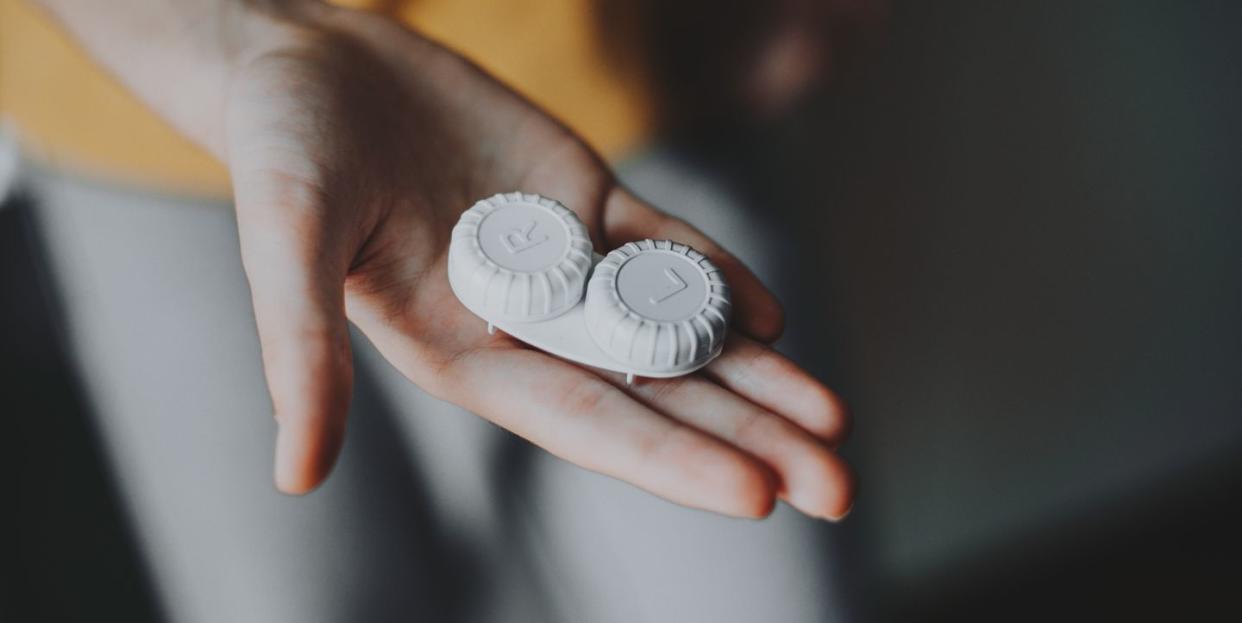New Study Finds ‘Forever Chemicals’ in Contacts: What You Need to Know

A new consumer study found that many popular contact lenses have elevated levels of "forever chemicals."
All 18 contact lenses tested contacted high levels of PFAS.
Experts say there's a lot we don't know at this point about the potential impact.
An estimated 45 million Americans wear contact lenses, but new research that connects contacts to cancer-causing chemicals is making plenty of people reconsider their use.
The consumer study analyzed 18 sets of contacts from the popular brands Acuvue, Alcon, and Coopervision for a group of chemicals known as per- and polyfluoroalkyl substances or PFAS. The researchers found that all 18 pairs had various levels of organic fluorine, an indicator of the presence of PFAS.
The study, which was organized by the Mamavation website, which focuses on non-toxic product recommendations, had the contacts tested in a lab that’s certified by the Environmental Protection Agency (EPA) to try to determine how much PFAS was in the products.
The researchers found that all of the contacts exceeded 100 parts per million (ppm) of organic fluorine, which is about 50,000 times more than the highest level that’s considered safe in drinking water by the EPA.
If you wear contact lenses—and many people do—it’s understandable to have questions and concerns. It’s important to point out that this is new information and, with that, there aren’t a lot of answers right now. Here’s what we know up to this point.
How concerned about this should you be?
That’s the million-dollar question. “It is absolutely unclear,” says Scott Belcher, Ph.D., a toxicology and environmental health sciences professor at North Carolina State University and scientific adviser on the study. “This is the first study to really point in this direction.”
Belcher says that scientists have known “for decades” that fluoropolymers were used in contacts but adds that they’re “not really regulated as far as toxicology assessments.”
Belcher, who wears contacts on occasion, says that “there really is a concern” with the findings. “We just can’t quantify that concern at this point,” he adds.
Bavand Youssefzadeh, O.D., an ophthalmologist at Global Lasik and Cateract Institute in Huntington Beach, Calif., agrees. "There's fluoro in a lot of things and we're becoming more aware of that," he says. "At this stage, this is definitely something to think about but there's not really evidence as to what the harms are just yet. Could this cause dry eye and eye allergies? We don't know."
It’s important to note that Acuvue, Alcon, and Coopervision were the only brands tested. It’s unknown based on the findings whether other brands also contain PFAS, but Belcher says it's "certainly possible."
What are PFAS, again?
PFAS, aka “forever chemicals” are a large group of synthetic chemicals that have been used in consumer products since the 1950s, per the National Institutes of Health (NIH). PFAS are widely used with good reason—they can do a lot. PFAS can help keep food from sticking to cookware, prevent stains on carpets, and even make firefighting foam.
But the chemicals don’t break down easily in the environment, and several have been linked to a slew of serious health conditions if people are exposed to them over time, including cancer, according to the Environmental Protection Agency (EPA). Research has also linked PFAS to obesity, infertility, thyroid disease, and other health conditions.
PFAS can also build up in your body over time, and people usually take in more PFAS than they excrete, per the NIH. Last year, the EPA announced new drinking water health advisories after determining that PFAS are more dangerous to people than scientists previously thought, and at lower levels than they originally believed were damaging.
What to do if you wear contacts
"I wouldn't not use my contacts just yet," Youssefzadeh says. Belcher also doesn’t recommend that you pitch your contacts, but says it’s important to be aware of the PFAS exposure. “I absolutely understand the importance of their functionality,” he says. “This is really a discussion to have with your prescribing ophthalmologist, bringing them up to speed that there is an additional concern.”
But Belcher says he has the same advice for people who are worried about what’s in their contacts as he does about plastics in general. “If you’re concerned, there are alternatives—whether that’s wearing glasses or turning to a different brand that performs at a level that you and your ophthalmologist are comfortable with,” he says.
Youssefzadeh says your eye doctor can talk you through your options, including hard contact lenses, Lasik surgery and glasses.
It's important to note that you're exposed to PFAS beyond more than just your contacts—PFAS can show up in plastic containers, nonstick pans, and personal care products to name a few. A 2015 report from the Centers for Disease Control and Prevention (CDC) found that 97% of Americans have PFAS in their blood, while a 2019 study found that 98% of Americans have PFAS in their blood.
Belcher stresses that there’s a lot we don’t know about PFAS and contacts at this point. “This is definitely one of those new areas where there is a lot of uncertainty surrounding what the potential adverse effects are and balancing them between the benefits,” he says. “It’s difficult right now. However, it’s great that consumers are beginning to be aware. If there is a concern, that is a plus in my opinion.”
You Might Also Like

